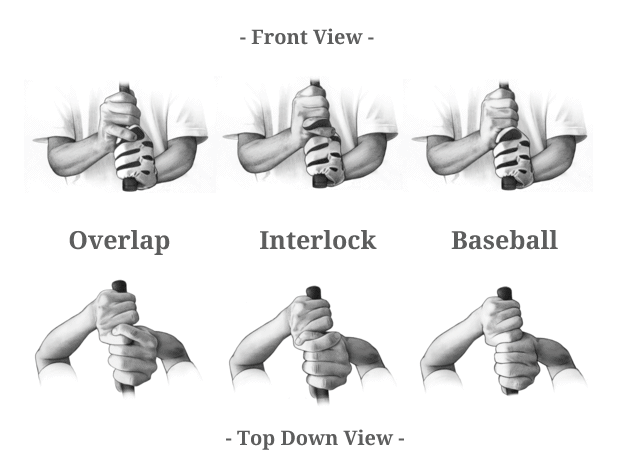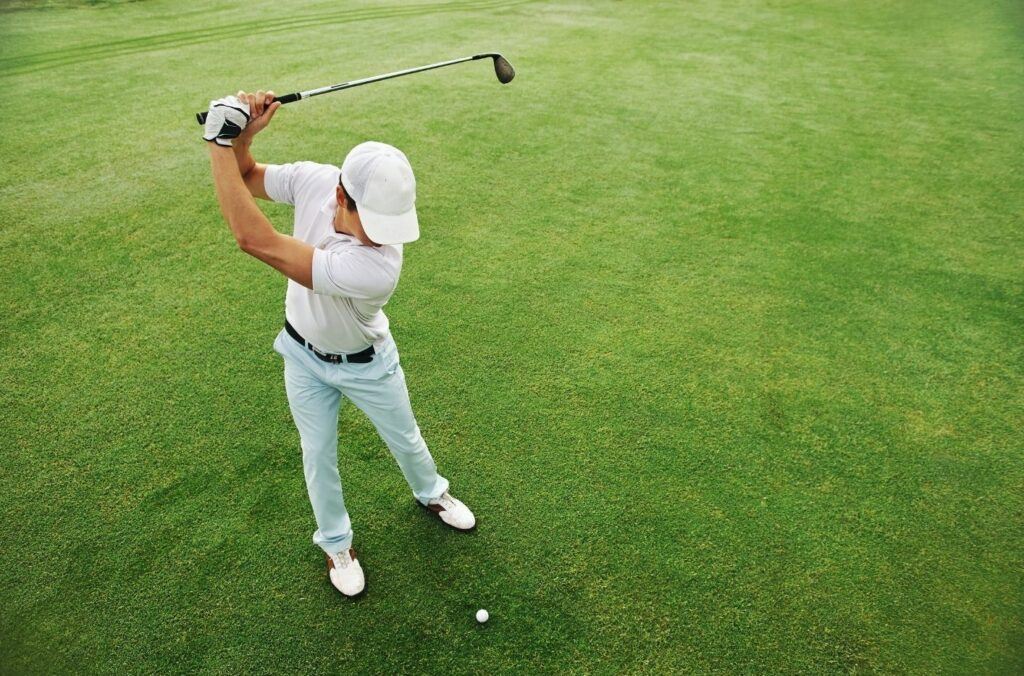Golf is an activity for all ages, shapes and sizes. Golf can be played by anyone of any skill level, but there are some things you should keep in mind to help you improve your game and get better at the sport. While we are all looking for the fastest ways to improve our golf, the below three tips will help you get on your way towards making your golf game more enjoyable. Let’s make your golf swing look as great as the accessories you have. Here are tips to improve your golf swing, we’ll explore them in detail!
1. Understand the fundamentals
2. Flexibility and Mobility
3. Drills
1. What are the fundamentals of golf that you should know about?
The fundamentals of golf you should know about are: grip, stance & posture, alignment, and the swing. If you don’t learn how to do these correctly from the very beginning, it will be difficult to correct later on when you’re a more experienced player.
Here are the fundamentals we think you should focus on when wanting to improve your golf game.
Grip
Your grip is your connection to the club. It is important to have a solid grip that allows you to keep the club face square when it comes into contact with the ball.
There are a few variations of the grip and it is usual that a golfer will adopt the one that allows them to perform a swing easily and effectively.

10-Finger Grip / Baseball Grip – It’s called the “10-finger grip” because every one of your fingers is on the club. Not many professionals use this grip, but some newcomers to the game find it comfortable.
It can be a powerful grip because each of your fingers are touching the surface off the grip, and can be a well-suited grip for a golfer with small hands.
Overlapping Grip – The overlapping or “vardon” grip is one of the most common in golf. This is when you positioning the pinkie finger of one hand and placing it in the ridge between your other hand’s index and middle finger.
This grip’s biggest advantage is beneficial for anyone with particularly large hands.
Interlocking Grip – The interlocking grip starts with the 10-finger grip; you simply interlock one hand’s pinkie finger with the other hand’s index finger to get your hands closer together.
The biggest advantage is that this ‘locks’ your fingers together so both of your hands work together, which can give your golf swing some added power.
Stance, Posture & Alignment
Posture, Stance and Position of Feet – Posture is an important and often overlooked fundamental in the game of golf. You should feel comfortable, agile, and in perfect balance before the start of any golf swing. First, set your feet shoulder width apart. This will provide a sufficient base to support an athletic body turn. You may want to widen your stance slightly (insteps of feet even with the outside of the shoulders) with the longer clubs to accommodate the wider swing arc. The back foot (right foot for right handed players) should be approximately perpendicular to the target line, while the front foot should be slightly open (toe pointing outward).
Knee Flex – Be sure that your knees are bent slightly. You should feel sturdy, stable, and grounded. Too much flex in the knees will lead to improper posture and leg action throughout the swing. On the other hand, insufficient flex or locked knees will cause restriction and a loss of power.
Weight Distribution – Weight distribution should be approximately 50/50 on each leg, or slightly favoring the back leg (right leg for right-handed players). Your center of gravity should never be placed forward of the center of your stance if possible. This allocation of your weight will enable a simple turn and shift “behind the ball” on the backswing.
Tilt of the Spine– Think of the spine as the axis around which body rotation and the entire golf swing takes place. Therefore, it is vital that this axis (spine) remains as straight as possible. Much like the axels for the wheels of a car, if they become bowed or bent, the wheels will wobble uncontrollably. Tilt your upper body forward, bending at the hip joints. If your spine is to remain straight, you must “stick out” your buttocks to maintain balance. Your center of gravity should remain in the center of your feet and neither toward the heels or the toes.
Head and Chin Position – The finishing touch to the perfect spine position is to keep your chin up. With the chin in your chest, your spine will be in a curved position and body rotation will be difficult.
Addressing the Ball. – A golf swing is an athletic motion and our stance should be athletic as well. We bow forward toward the ball to prepare for a swing along an inclined plane. Be sure to maintain a relatively straight, stable spine as this is the axis around which everything rotates. Stay balanced with weight evenly distributed from toes to heels and left leg versus right leg. Allow arms to hang naturally, where ever your hands come together is where we should grip the club.
Swing
There are 4 components to a golf swing – backswing, downswing, impact and follow through.
Start your backswing. The backswing is where you lift the club back from its starting position and bring it above your head. Try to rotate the torso on the backswing by shifting weight from the ball of your front foot to the ball of your back foot. Pay attention to the three distinct phases of the backswing:
- Phase one: Move the hands straight back while keeping them close to your back leg. Try to keep your front arm straight while you do this. As the club head hinges backward between your left arm and the club shaft, the shaft becomes almost parallel to the ground.
- Phase two: Continue a slight wrist break as you move your arm parallel to the ground. The club should be roughly perpendicular to your left arm (for right-handed golfers). The end of the club should be pointing slightly outside the golf ball.
- Phase three: Rotate your torso back even further so that the clubhead travels slightly behind your hands at the top of the backswing. Your front arm should bend slightly during the last phase of the backswing.
Follow through with your downswing. When swinging down, it should feel like you are dragging or slightly pulling the head of the club so that it lags behind everything else. Allow the 90-degree forearm/shaft angle to increase, then unwind rapidly through the impact area. This creates tremendous clubhead speed while allowing the body to move relatively slowly and maintain control.
- Right before impact, try to lock your front arm again so that it’s completely straight again, just how it was when you started your backswing.
- During your downswing, shift your weight from the ball of your back foot to the ball of your front foot. Allow your knees to move toward your target. Try to keep your front knee flexed, especially if you’re hitting a driver, as this will help your front leg take your weight.
Make sure to have the shaft leaning forward toward the target at the moment of impact. This will help ensure that your hands are ahead of the club head during impact, which in turn helps the club head strike the ball before moving through the ground. Don’t forget to use your hips to swing energy into your shot; don’t just rely on your hands to produce the power.
Remember to follow through. It isn’t critical how far back you take the club, but if you release the club correctly, you should follow through completely. Your belt buckle will be facing the target, the club will have swung through to a position somewhat behind you, and you will be balanced on your lead foot with the back foot balanced on its toe. You should be able to comfortably hold this finish as you watch the ball fly off into the distance.
- Keep your eyes on the ball during the backswing, downswing, and follow through. Don’t lift your head as soon as you hit the ball to see where it’s going; this will only cause you to mis-hit the ball. Keep your eyes on the ball until you’ve finished your follow through.
Don’t try to pummel the ball with all your strength — easy does it! Just as you shouldn’t try to strangle your golf club in your grip, you shouldn’t try to pound the golf ball with all your strength. The most important factor in achieving distance and direction is form, and good form is usually sacrificed when you try to go caveman on the golf ball.
2. Flexibility & Mobility
These are largely overlooked components for the ordinary golfer but are very important if you want to make the most of the above fundamentals.
Golf requires great flexibility in all joints, but specifically hips and shoulders.
As we age, and if we do not pay attention to these areas our flexibility and mobility reduces. There are very simple and effective ways that you can keep or improve your flexibility.
Good flexibility will allow you to perform full and fluid golf swings. You can find some basic stretches that you can do at home HERE
3. Drills
Good drills are designed in such a way that they allow you to feel a specific movement or position which you will need in your swing. Drills allow you to get involved in the process of improving your technique, building and improving the essentials required.
When first starting out and if you are unsure if you are doing the drills correctly you could look to have a session with a local club pro to get some feedback. This will help you understand how the right movements feel so when you practice on your own you will know when you are hitting the right movements. The internet is a great source to find drills and tips. You can find some drills here.
In conclusion, golf is a fantastic sport for all ages, shapes and abilities. While there are a few things to think about, the process to learn and develop muscle memory for those good shots just takes a little dedication and persistence, so get out there and get practicing!

